If crossing midline was a product or company, I would be their brand ambassador. I mean, I really, really have this nerdy obsession with crossing midline. I love talking about it, educating about its importance, and seeing how many times in a day I can set up environments to encourage it!

Crossing Midline 101
- Midline is an imaginary line that runs from your head to your toes, separating your right side from your left side.
- The brain’s 2 hemispheres specializes in different skills. In addition, the left side of your brain controls the right side of your body’s motor movements, and vice versa.
- Every time you move the right side of your body across to your left side (or vice versa), you are “crossing midline” and the neurons between left and right hemispheres of your brain are firing and communicating.
- Many children who avoid crossing midline experience learning challenges as well as motor challenges due to the lack of integration between both sides of the brain.
What It Looks Like
The most common way to cross midline involves using your upper extremities in a functional task. Involving upper trunk rotation (when your upper body/torso rotates across your body while your lower body remains stationary) is key in crossing midline. Here are some everyday activities that you might cross midline in, without even noticing.
- Washing a window or erasing a chalkboard: as your feet remain stationary and you reach across your body in horizontal sweeping motions, you are crossing midline!
- Removing/putting on a seat belt: as you’re sitting, your lower body remains stationary and you are reaching across your body to buckle/unbuckle the belt.
- Sitting at the dinner table reaching for a glass/utensil on the opposite side of your dominant hand.
- Washing dishes and putting them away on the opposite side of the body.
Tips To Encourage Midline Crossing
Opportunities for crossing midline come up everywhere, but it’s so interesting to note how many children avoid it. For example, you might notice a child reaches for a Lego piece on their right side of their body, then transfers it to their left hand instead of crossing over. You can read more about how to recognize avoiding midline crossing here. For these kids, you might have to get more creative at setting up their environment to cross midline.
- Keep their lower body stationary by straddling a yoga ball or sitting in a chair while engaging in an activity
- Try placing an object in their non-dominant hand or give an activity that requires their non-dominant hand to hold it steady, so their dominant hand has to do all the work and cannot transfer items into their non-dominant hand
- Place target items (puzzle board, magnet board, basket) on their non dominant side so they have to place pieces (puzzles, magnets, balls) into the target item with their dominant hand.
Providing opportunities for your kids/clients to cross midline through everyday activities will enhance their motor skills as well as higher level academic skills.
If you find fun ways to encourage crossing midline, share them with me! Tag me on instagram @TheOTButterfly
You Might Be Interested In
Free crossing midline info sheet
Crossing midline handwriting game
3 Easy Ways to encourage crossing midline
Summer Crossing The Midline Activities
Meet The Author Laura

Laura is a pediatric OT who works with children with sensory processing disorder and other developmental disabilities. Laura has a passion for educating teachers and parents about the impact of sensory processing on children’s success and learning abilities. Through social media, her blog and her teachers pay teachers store, Laura shares her unique resources and creative ideas for supporting children in their visual motor, sensory and emotional regulation development.
You can learn more from her on her Website The OT Butterfly and her resources can be found at her Teachers Pay Teachers Store.

Hi there! I love the information you shared here!
I am a special education teacher and I am very much interested in how things like crossing the midline impacts learning.
Do you happen to have any resources (e.g. articles, books, etc.) that discuss in further detail why crossing the midline is so important?
I have saved this on my Pintrest for future reference. I would love to know more!